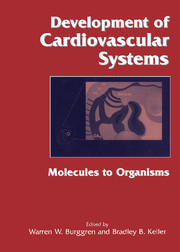Book contents
- Frontmatter
- Contents
- List of contributors
- Foreword by Constance Weinstein
- Introduction: Why study cardiovascular development?
- Part I Molecular, cellular, and integrative mechanisms determining cardiovascular development
- Part II Species diversity in cardiovascular development
- 9 Evolution of cardiovascular systems: Insights into ontogeny
- 10 Morphogenesis of vertebrate hearts
- 11 Invertebrate cardiovascular development
- 12 Piscine cardiovascular development
- 13 Amphibian cardiovascular development
- 14 Reptilian cardiovascular development
- 15 Avian cardiovascular development
- 16 Mammalian cardiovascular development: Physiology and functional reserve of the fetal heart
- Part III Environment and disease in cardiovascular development
- Epilogue: Future directions in developmental cardiovascular sciences
- References
- Systematic index
- Subject index
11 - Invertebrate cardiovascular development
from Part II - Species diversity in cardiovascular development
Published online by Cambridge University Press: 10 May 2010
- Frontmatter
- Contents
- List of contributors
- Foreword by Constance Weinstein
- Introduction: Why study cardiovascular development?
- Part I Molecular, cellular, and integrative mechanisms determining cardiovascular development
- Part II Species diversity in cardiovascular development
- 9 Evolution of cardiovascular systems: Insights into ontogeny
- 10 Morphogenesis of vertebrate hearts
- 11 Invertebrate cardiovascular development
- 12 Piscine cardiovascular development
- 13 Amphibian cardiovascular development
- 14 Reptilian cardiovascular development
- 15 Avian cardiovascular development
- 16 Mammalian cardiovascular development: Physiology and functional reserve of the fetal heart
- Part III Environment and disease in cardiovascular development
- Epilogue: Future directions in developmental cardiovascular sciences
- References
- Systematic index
- Subject index
Summary
Introduction
Despite the long history of descriptive invertebrate embryology, there have been few studies specifically on the functional development of the heart or circulatory system. Some mention of the initiation of heartbeat or of some ultrastructural details of heart muscle information have been included en passant in a number of studies, but hardly any studies specifically address the physiology of the developing heart.
Even for adult invertebrates cardiovascular physiology is poorly understood (McMahon, Smith, & Wilkens, 1997). What information we do have is sketchy. For instance, we know a great deal about the physiology of the cardiac control system in crustacean arthropods (Cooke, 1988) but much less about the generation of heartbeat in any other invertebrate group. For these reasons this chapter is limited to a protostome group, including the annelids, arthropods, and molluscs, and a deuterostome group, including the echinoderms, hemichordates, and urochordates, for which there is (1) a modicum of knowledge concerning cardiovascular development and (2) sufficient knowledge of the physiology of the adult cardiovascular system to allow some interpretation of developmental changes. Since there is great diversity in the structure of invertebrate circulatory systems, this chapter is organized by taxonomic group rather than by process. To facilitate comprehension of the evolutionary relationship between the groups covered and the protovertebrates a simplified evolutionary tree is given in Figure 11.1.
Annelida
The structure of adult annelid blood vascular systems has been summarized by Hanson (1949) and Martin (1980); the latter author also examined the phylogenetic and ontogenetic origin of the system, particularly the heart.
- Type
- Chapter
- Information
- Development of Cardiovascular SystemsMolecules to Organisms, pp. 127 - 144Publisher: Cambridge University PressPrint publication year: 1998
- 1
- Cited by



